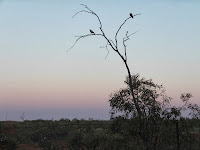.JPG) |
| CLEAVERVILLE BEACH |
 |
| YES, A BEACH FOR SHAYDEN'S GAME! SHAYDEN ALSO HAD A TOUCH OF MADISON'S PROBLEM, BUT HE IS OKAY NOW |
TUES 17 - THUR 19.9.2013: We decided to stay at Cleaverville Beach ($45.00 for 8 nights), located 26 kilometres north-west of Karratha. It is popular for extended and overnight camping or day trips and has a number of secluded scenic sites. Access to Cleaverville Beach is via a 13 km maintained gravel road. It is amazing how long 13 kms feels when your top speed is 20kph! Absolutely love this stay, bar one problem - the sandflies and mosquitoes. Normally when you speak to people and they continually scratch you tend to take a step backwards, but here at Cleaverville it is an accepted idiosyncrasy - somewhat akin to a local cultural practice! We have used every type of insect repellent and the latest providing relief is a roll on deodorant (no particular brand), for easing the itch and a mixture of Dettol, Eucalyptus and Sorbeline for bite prevention - not sure if the intent is to inebriate or anaesthetise the insects!
 |
| NOT A BAD VIEW! |
 |
| 'BUNGARRA' - THERE ARE 5 DIFFERENT GOANNA SPECIES |
 |
| CLEAVERVILLE CAMP AREA |


























.JPG)

.JPG)




















